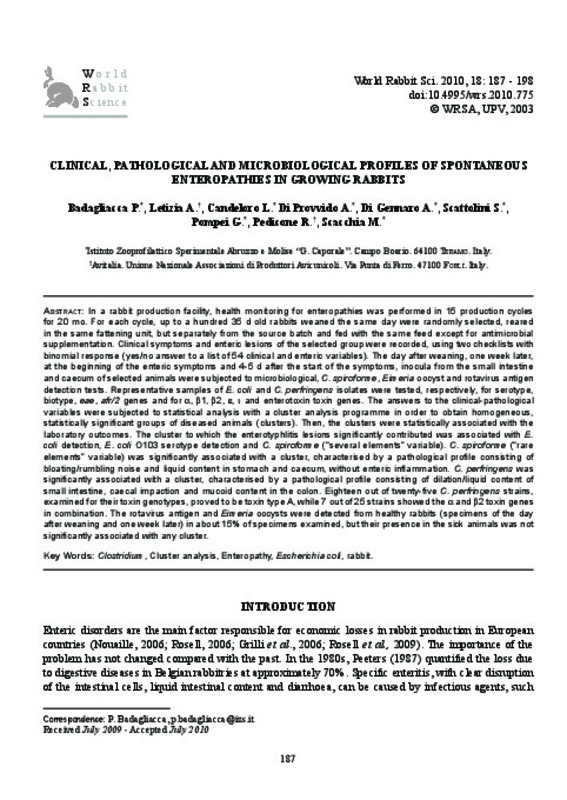|
Resumen:
|
[EN] In a rabbit production facility, health monitoring for enteropathies was performed in 15 production cycles for 20 mo. For each cycle, up to a hundred 35 d old rabbits weaned the same day were randomly selected, reared ...[+]
[EN] In a rabbit production facility, health monitoring for enteropathies was performed in 15 production cycles for 20 mo. For each cycle, up to a hundred 35 d old rabbits weaned the same day were randomly selected, reared in the same fattening unit, but separately from the source batch and fed with the same feed except for antimicrobial supplementation. Clinical symptoms and enteric lesions of the selected group were recorded, using two checklists with binomial response (yes/no answer to a list of 54 clinical and enteric variables). The day after weaning, one week later, at the beginning of the enteric symptoms and 4-5 d after the start of the symptoms, inocula from the small intestine and caecum of selected animals were subjected to microbiological, C. spiroforme, Eimeria oocyst and rotavirus antigen detection tests. Representative samples of E. coli and C. perfringens isolates were tested, respectively, for serotype, biotype, eae, afr/2 genes and for a, b1, b2, e, i and enterotoxin toxin genes. The answers to the clinical-pathological variables were subjected to statistical analysis with a cluster analysis programme in order to obtain homogeneous, statistically significant groups of diseased animals (clusters). Then, the clusters were statistically associated with the laboratory outcomes. The cluster to which the enterotyphlitis lesions significantly contributed was associated with E. coli detection, E. coli O103 serotype detection and C. spiroforme ("several elements" variable). C. spiroforme ("rare elements" variable) was significantly associated with a cluster, characterised by a pathological profile consisting of bloating/rumbling noise and liquid content in stomach and caecum, without enteric inflammation. C. perfringens was significantly associated with a cluster, characterised by a pathological profile consisting of dilation/liquid content of small intestine, caecal impaction and mucoid content in the colon. Eighteen out of twenty-fi ve C. perfringens strains, examined for their toxin genotypes, proved to be toxin type A, while 7 out of 25 strains showed the a and b2 toxin genes in combination. The rotavirus antigen and Eimeria oocysts were detected from healthy rabbits (specimens of the day after weaning and one week later) in about 15% of specimens examined, but their presence in the sick animals was not significantly associated with any cluster.
[-]
|
|
Agradecimientos:
|
This study was supported by a financial contribution from Avitalia, Unione Nazionale Associazioni di Produttori Avicunicoli, Forlì, Italy, as part of the programme entitled “Miglioramento della qualità, della gestione ...[+]
This study was supported by a financial contribution from Avitalia, Unione Nazionale Associazioni di Produttori Avicunicoli, Forlì, Italy, as part of the programme entitled “Miglioramento della qualità, della gestione dell’offerta delle produzioni cunicole e di rafforzamento dei rapporti di filiera. Azione 4.3”. Our thanks go to breeder Leta Covelli and Dasco srl for supplying the rabbits, to our colleague Romolo Salini and to Fabrizio Agnoletti of the Istituto Zooprofilattico Sperimentale del Veneto, Trevise, Italy
[-]
|








